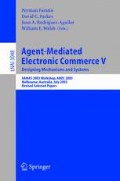Abstract
We introduce take-it-or-leave-it auctions (TLAs) as an allocation mechanism that allows buyers to retain much of their private valuation information as do the most common auction mechanisms (English and Dutch auctions), yet, unlike them, generates close-to-optimal expected utility for the seller. We show that if each buyer receives at most one offer, each buyer’s dominant strategy is to act truthfully. In more general TLAs, the buyers’ optimal strategies are more intricate, and we derive the perfect Bayesian equilibrium for the game. We develop algorithms for finding the equilibrium and also for optimizing the offers in both types of TLAs so as to maximize the seller’s expected utility. We prove that optimal TLAs have many desirable features. In several example settings we show that the seller’s expected utility already is close to optimal for a small number of offers. As the number of buyers increases, the seller’s expected utility increases, and becomes increasingly (but not monotonically) more competitive with Myerson’s expected utility maximizing auction. Myerson’s uses full valuation revelation and is arguably impractical because its rules are unintuitive, unlike ours.
This material is based upon work supported by the National Science Foundation under CAREER Award IRI-9703122, Grant IIS-9800994, ITR IIS-0081246, and ITR IIS-0121678.
Access this chapter
Tax calculation will be finalised at checkout
Purchases are for personal use only
Preview
Unable to display preview. Download preview PDF.
References
Krishna, V.: Auction Theory. Academic Press, London (2002)
Vickrey, W.: Counterspeculation, auctions, and competitive sealed tenders. Journal of Finance 16, 8–37 (1961)
Monderer, D., Tennenholtz, M.: Optimal auctions revisited. In: Proceedings of the National Conference on Artificial Intelligence (AAAI), Madison, WI, pp. 32–37 (1998)
Ronen, A.: On approximating optimal auctions. In: Proceedings of the ACM Conference on Electronic Commerce (ACM-EC), Tampa, FL, pp. 11–17 (2001)
Myerson, R.: Optimal auction design. Mathematics of Operation Research 6, 58–73 (1981)
Naor, M., Pinkas, B., Sumner, R.: Privacy preserving auctions and mechanism design. In: Proceedings of the ACM Conference on Electronic Commerce (ACMEC), Denver, CO (1999)
Rothkopf, M.H., Teisberg, T.J., Kahn, E.P.: Why are Vickrey auctions rare? Journal of Political Economy 98, 94–109 (1990)
Conitzer, V., Sandholm, T.: Complexity of mechanism design. In: Proceedings of the 18th Annual Conference on Uncertainty in Artificial Intelligence (UAI-2002), Edmonton, Canada, pp. 103–110 (2002)
Ronen, A., Saberi, A.: Optimal auctions are hard. In: FOCS, pp. 396–405 (2002)
Fudenberg, D., Tirole, J.: Game Theory. MIT Press, Cambridge (1991)
Sandholm, T.: An implementation of the contract net protocol based on marginal cost calculations. In: Proceedings of the National Conference on Artificial Intelligence (AAAI), Washington, D.C, pp. 256–262 (1993)
Sandholm, T.: Issues in computational Vickrey auctions. International Journal of Electronic Commerce 4, 107–129 (2000); Special Issue on Applying Intelligent Agents for Electronic Commerce; A short, early version appeared at the Second International Conference on Multi–Agent Systems (ICMAS), pp. 299–306 (1996)
Parkes, D.C.: Optimal auction design for agents with hard valuation problems. In: Agent-Mediated Electronic Commerce Workshop at the International Joint Conference on Artificial Intelligence, Stockholm, Sweden (1999)
Larson, K., Sandholm, T.: Costly valuation computation in auctions. In: Theoretical Aspects of Rationality and Knowledge (TARK VIII), Sienna, Italy, pp. 169–182 (2001)
Fudenberg, D., Tirole, J.: Perfect bayesian equilibrium and sequential equilibrium. Journal of Economic Theory 53, 236–260 (1991)
Blumrosen, L., Nisan, N.: Auctions with severely bounded communication. In: FOCS, pp. 406–415 (2002)
Bergemann, D., Pesendorfer, M.: Information structures in optimal auctions. Discussion Paper 1323, Cowles Foundation for Research in Economics, Yale University, New Haven, CT (2001)
Amazon.com: Gold box offers (2003), http://www.amazon.com/gold-box
Lavi, R., Nisan, N.: Competitive analysis of incentive compatible on-line auctions. In: Proceedings of the ACM Conference on Electronic Commerce (ACM-EC), Minneapolis, MN, pp. 233–241 (2000)
Blum, A., Sandholm, T., Zinkevich, M.: Online algorithms for market clearing. In: Annual ACM-SIAM Symposium on Discrete Algorithms (SODA), San Francisco, pp. 971–980 (2002)
Author information
Authors and Affiliations
Editor information
Editors and Affiliations
Rights and permissions
Copyright information
© 2004 Springer-Verlag Berlin Heidelberg
About this paper
Cite this paper
Sandholm, T., Gilpin, A. (2004). Sequences of Take-It-or-Leave-It Offers: Near-Optimal Auctions Without Full Valuation Revelation. In: Faratin, P., Parkes, D.C., Rodríguez-Aguilar, J.A., Walsh, W.E. (eds) Agent-Mediated Electronic Commerce V. Designing Mechanisms and Systems. AMEC 2003. Lecture Notes in Computer Science(), vol 3048. Springer, Berlin, Heidelberg. https://doi.org/10.1007/978-3-540-25947-3_5
Download citation
DOI: https://doi.org/10.1007/978-3-540-25947-3_5
Publisher Name: Springer, Berlin, Heidelberg
Print ISBN: 978-3-540-22674-1
Online ISBN: 978-3-540-25947-3
eBook Packages: Springer Book Archive

